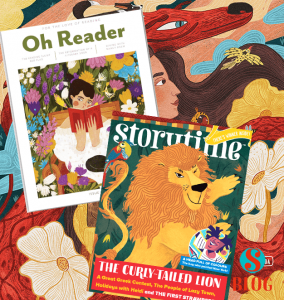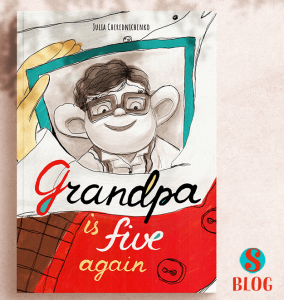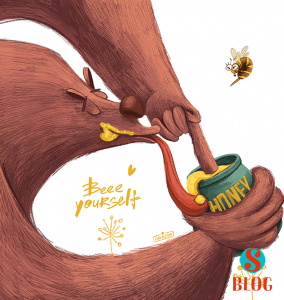
Illustrator Interview with Julia Cherednichenko
This month, we are thrilled to have the chance to sit down and chat to the amazing Ukrainian artist Julia Cherednichenko. She did the wonderful illustrations for The Curly-Tailed Lion in Storytime 93, and we are keen to find out more about her work!
1. When did you realize that you wanted to be an artist?
Looking back now, I can see that an extraordinary combination of circumstances brought me to this point. I still feel as if there was some magic involved, or that the universe intended things to work out this way. I’ll try to explain!
I have doing art all my life, but it was just a hobby. When I was 8 or 9 years old, my parents enrolled me in art school, but I left a year later because of health reasons. My formal training as an artist ended. But when you have a passion, some things become inevitable. All my life, my passion was creating things with my hands. I drew, sculpted, embroidered, sewed, and took photos – but those were just hobbies that were good for my soul.
Sometimes, other people told me that I have a talent for art and craft. “You should be an artist,” they said. However, what does it mean to be an artist? To just have talent is not enough!
You need to immerse yourself in the profession. That is how you get knowledge, experience and good mentors. You should have your own motivation to improve your professional skills – and just as important, there should be a pleasant atmosphere around you.
In the society where I grew up and studied, becoming a professional artist was quite difficult, so many budding artists choose other careers. That’s what happened to me.
First, I became an international economist, and then I worked as a manager for 3 years. Everything seemed okay, but I felt that I was not in the right place, and that I was living somebody else’s life, not mine. The first war in the eastern part of Ukraine in 2014 changed everything for me.
I had to move to another part of my country. It was a difficult but very important time for me. During this long ‘trip’ I realized a lot of things. One was that I didn’t want to be a manager or economist anymore. I needed to change something, take control of my life, and choose what I wanted to do. Most of all, I dreamed of changing the world. To make it better, to have make an impact on it, to bring beauty. At that time, I didn’t have any idea about how to do this. I just wanted to find out how to move forward. The answer soon arrived!
One night 7 years ago, I had a dream. It was very beautiful and so realistic. It gave me all the answers I needed. My subconscious told me that I should draw children’s books, that I am an artist, and that I shouldn’t forget this. If I wanted to change something, I should do it right now. The next morning, I got up and I knew who I was. That dream changed everything in my life.
At 25, I made a conscious choice to become an artist and draw children’s books, and to improve my skills in illustration and design. Creating art is my way to be heard, to have a chance to make this world a little better.
2. How did you develop your artistic skills and make a career out of art?
 Just two words – learning and practice. Every day, I learn something new. I try to discover things that help me to develop in all ways. For example, every morning I read a useful book and watch an instructional video. I have attended a lot of masterclasses and online courses in illustration, design, writing, and even the art of planning. This helps me to develop myself and my skills every day.
Just two words – learning and practice. Every day, I learn something new. I try to discover things that help me to develop in all ways. For example, every morning I read a useful book and watch an instructional video. I have attended a lot of masterclasses and online courses in illustration, design, writing, and even the art of planning. This helps me to develop myself and my skills every day.
As far as professional skills go – for me, the basic step was education. As I said, I had decided to become an artist in a very dark time. I knew that I wanted to start doing graphic design. I didn’t know anything in this field – I had some knowledge of Photoshop and Illustrator software, but that wasn’t enough. There was so much more to learn. I think that when you choose art as a profession, you should be ready to study for your whole life.
At that time, my main questions were: “How do I avoid getting lost?”, “How do I make sure I don’t miss important information?” and “How do I make the right choices in my design studies?” It was too much for me at first.
I understood that one day I want to be a very good professional. Therefore, I had to learn from professionals and complete a good education programme that would help me to improve my skills, become competitive, and develop as a creator. I found all these things during my education as a graphic designer.
I had the chance to learn so many things that I wouldn’t have discovered on my own. I wouldn’t have known about lots of important techniques. When you have a general understanding of what a field includes, you can improve yourself in any direction. This is how I got into illustration.
3. Who are your favourite artists? Also, are there other people who have inspired you?
Oh, that’s a very hard question! There are so many artists with so many beautiful works that it can be difficult to decide which ones I like best. I love many different illustrators and designers. I’ll list some of them: Carson Elis, Rebecca Green, Julia Sarda, Rebecca Dautremer, Giulia Pintus, Jean Jullien, Anton Van Hertbrugge and many more. I also have to mention Utagawa Kunisada and my favourite, Picasso. This list could be longer! I am also inspired by fiction and nonfiction literature, adventure movies, anything that can capture my eyes or heart. It can be a book, an artwork, a movie, a ballet, an opera, or a theatre performance. I’m especially inspired by the passion of creators.
4. What media and techniques do you use to create your art? Are there any that you would like to experiment with?
Most of my drawings are created using either mixed or digital techniques on my iPad and laptop. I can’t say that I work only in Procreate, for example, or in Photoshop. I’m an illustrator and designer – so I use many programs, such as Procreate and Designer on the iPad and Photoshop, Illustrator, InDesign, and many more on the laptop for creating illustrations and layouts for books, packaging or products. Besides using digital stuff, I work with traditional techniques – pencils, markers, ink, gouache, acrylic and stamps. I like to mix textures and elements created using traditional techniques with digital illustration. It is interesting to experiment with different means of expression in projects.
Before starting the illustration/book/packaging, I need to understand what style and technique will work best and what new and unexpected possibilities I’ll have by changing the means of creation.
I feel that I have to experiment more with traditional techniques. For example, to work more with hand-drawing and sketching and mixing traditional materials and digital art in one picture. Such experiments can give more freedom, but it also take more time and don’t always work for a project.
5. What are your favourite subjects to draw? (We have noticed that you are particularly good at doing animals, which made you a natural choice for doing our recent story about a celebrity lion!)
 Oh, thank you very much! It doesn’t really matter to me whether I draw people or animals or nature. The main thing is the idea, soul and hidden meaning of the illustration. In every picture and every character, I try to put a little part of my vision and feelings, something from my experiences, memories, or situations that will evoke emotions in people. It doesn’t matter to me who the character is. I’ll do my best to ‘believe in’ every figure. When you can look at the picture and understand what the character feels, or catch the thought – “Oh, it’s true, it’s about me, it’s me!”
Oh, thank you very much! It doesn’t really matter to me whether I draw people or animals or nature. The main thing is the idea, soul and hidden meaning of the illustration. In every picture and every character, I try to put a little part of my vision and feelings, something from my experiences, memories, or situations that will evoke emotions in people. It doesn’t matter to me who the character is. I’ll do my best to ‘believe in’ every figure. When you can look at the picture and understand what the character feels, or catch the thought – “Oh, it’s true, it’s about me, it’s me!”
In general, maybe yes, I draw animals more often. I like to observe animals – they are funny, cute and unpredictable. I can imagine any amusing situation with them. Moreover, I have a dog and a cat at home, and I often make sketches and illustrations about their relationship. Sometimes they are so weird! I just have to show this in my pictures. In one sentence, it is never boring with them.
Nevertheless, please don’t think that I only draw animals! I have many illustrations of people, especially children. For example, I have been creating a book for the last 6 months in which there are more than 100 characters, both children and adults. It is a work in progress now, so I don’t know the exact number. Anyway, I hope it will appeal to children all over the world when it comes out!
6. We recently had a chance to read a wonderful book that you wrote and illustrated! What inspired you to create Grandpa is Five Again?
 I’ll describe to you my thoughts and feelings at that time. Before I started work on this book, I decided to find out more about the process of writing and storytelling. My work is connected with creating books (especially picture books) and pictures for stories, so I have to know not only how to draw, but also how to write text and build a world for the story – how to create it using words as well as illustrations. I thought this knowledge would help me in the illustration process. I wanted to know more, to be better as a professional, and to improve myself. To skip ahead, yes, it did work for me!
I’ll describe to you my thoughts and feelings at that time. Before I started work on this book, I decided to find out more about the process of writing and storytelling. My work is connected with creating books (especially picture books) and pictures for stories, so I have to know not only how to draw, but also how to write text and build a world for the story – how to create it using words as well as illustrations. I thought this knowledge would help me in the illustration process. I wanted to know more, to be better as a professional, and to improve myself. To skip ahead, yes, it did work for me!
I discovered that the process of storytelling is exciting for me, and I came up with so many ideas. Moreover, I wanted to create them with words and pictures. It could be my way to help somebody, to change something, to make this world slightly better by touching the feeling and thoughts of other people, children and adults alike.
Grandpa is Five Again is such a book. It is a picture book about a small boy who has lost his best friend forever. It is difficult but important to talk about death, and I tried to approach it in a fresh way. I talk about how a small child deals with this situation, the sadness and loneliness, using play and imagination. How can this help them to process memories, friendship and love as well as sorrow? I try to explain things from the point of view of a child, in a light and funny way.
I chose this topic because I feel that people often avoid talking about death. I can understand why. It is very hard for adults to deal with emotions that come from it. We get into the habit of protecting ourselves from sad emotions and avoiding difficult topics, and we want to protect children in such a way, too. In lots of families this topic isn’t discussed, because nobody knows what to say.
We need to talk with children about it. We should show them that these emotions are normal, and that death is a part of life. We shouldn’t be scared, because we can’t lose somebody who is in our heart.
I have tried to write a very kind and honest story, full of love, and to create honest illustrations for it. I chose to use traditional techniques (gouache and ink), with a limited color palette for the same reason. It is the most honest way to portray this topic.
I found this idea so important to share with children and adults all over the world – especially now, in hard times, when so many people have lost their homes and families in our country. I am hoping to find the publisher for this book.
7. What projects would you like to work on in the future? Do you have any lined up that you would like to tell us about?
It is a little hard to talk about future plans, but I will try. I am concentrating my attention on two fields: children’s illustration for books and magazines, and packaging designs for brands. Both fields inspire me very much and I have many ideas to offer. So I’d like to find companies and publishers that share my views and aspirations. At the beginning of this year, I had thoughts about organising my own exhibition, but I didn’t manage to begin this process before the war in Ukraine started. I hope I’ll have a better chance in the future, maybe this year or next year.
To talk about my current job. I have two big projects that should be finished soon. One project is a children’s book for a private client. I will have it finished before June if the situation in Ukraine is okay. I’m working on the second project now with a lovely Ukrainian clothing brand. I have three projects that I have been working on for the past four months, but two of them have been delayed because of the situation in Ukraine. One project, with a product and packaging design about Ukraine, will come out soon in May.
This year, I want to find an illustration agency that can represent me in other countries. Of course, I hope to continue working with your magazine. I hope to work more with international publishers and brands, and to find a publisher for my book, Grandpa Is Five Again. I want to continue writing and creating my projects. I feel inspired by this field, and hopefully you will have a chance to see the results soon!
8. What can you tell us about your creative process? How do you find inspiration and plan your work?
 It depends on the project. Sometimes it is easy to find an idea, and sometimes I need to spend a lot of time searching, looking for something, even though I don’t know what it is. This process may be familiar to many other creators! When I have a project, I need to find the best concept for its realization.
It depends on the project. Sometimes it is easy to find an idea, and sometimes I need to spend a lot of time searching, looking for something, even though I don’t know what it is. This process may be familiar to many other creators! When I have a project, I need to find the best concept for its realization.
When I begin, I make a small plan of the project. I write down and draw out roughly what is going to be in each section. During this process, I search for information concerning the project. It can be anything – books, pictures, articles, photos, all of these can help me to figure out the concept. I just put little pencil marks where I think things have to be, because I realize that I can forget about something. I need to see all the details, thoughts and ideas and capture the whole picture of the illustration for the book or packaging.
I create a big mood board and brainstorm for each project. Most of all, I try to find many photos of the people or things that I need to draw. There can be pictures with lovely colors, clothes, patterns or details that I can use to help me create. If I need historical information, I look it up in articles, books etc.
I am inspired by the world around me. My main goal is to be attentive. I don’t close my eyes. Even if I don’t have a project in progress, I still need to observe everything around me (people, situations, nature, things). On the other hand, I am inspired by movies, books, and art of all kinds – especially from different nations, the ancient world, and epochs from medieval to modern times. Different styles of painting, architecture, clothes, and design are very inspiring.
After this, when I have my mood board and concept ready, I start my creative process. I try to work for no more than 6 hours every day (not including weekends) because I believe the best results are achieved when I’m well rested and full of energy. It is very important for me to have a good work/life balance. Of course, sometimes it doesn’t work out that way – but I do my best!
9. Like everyone else, we are looking on with shock at what is happening in your home country. Do you find that being creative helps in some small way to deal with such tragic events?
Yes, in some way. Art has already saved and changed my life. Nowadays, it helps me very much as well. At first, you are shocked and you can’t do anything. Then you have a choice about what information you want to concentrate your attention on. Art is a very personal thing. Every person can express their emotions without words, just using visual symbols, and it helps to unravel your thoughts and keep conscious in any unexpected and unpredictable situation. It can be very helpful to make a daily routine. My daily routine is creation. When I don’t have words, I can talk in the language of art. I have a choice about what to think, feel or do. My choice is to continue creating in any situation.
10. Is there a final message you would like to share with our readers? How can we support Ukrainian artists more?
Be creative, be brave, be yourself. In any situation. do what you can. Be inspired. Keep finding the way forward for yourself. Do only what you want in your soul. The life is short. Don’t stop improving yourself.
I think nowadays that any support is worth much more than we can imagine. I think that the main mission of the creative world is to inform other artists that they are not alone. I feel that many artists have lost themselves in these hard times. They lost their way, their inspiration, and their job. Most of them don’t know that their art is wanted by people in other countries. There are so many creators who are afraid to enter the international market for various reasons, such as language barriers, a lack of information or a lack of self-confidence.
The best way to support Ukrainian artists is to talk to them. To inform them that their art is still wanted all over the world. That European publishers are open to working with the best Ukrainian illustrators and designers, that you are ready to receive their portfolios. Thinking in such a way, we can find so many ways to give support – through exhibitions, portfolio reviews, organization, and supporting art events for illustrators, designers and all other creators in Ukraine and all over the world.
There isn’t only one right way to help. We can find many solutions to support Ukrainian creators. In any case, the most important step is to continue informing other artists that they are not alone.




